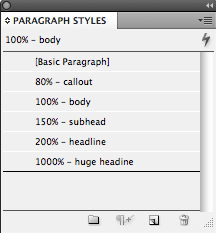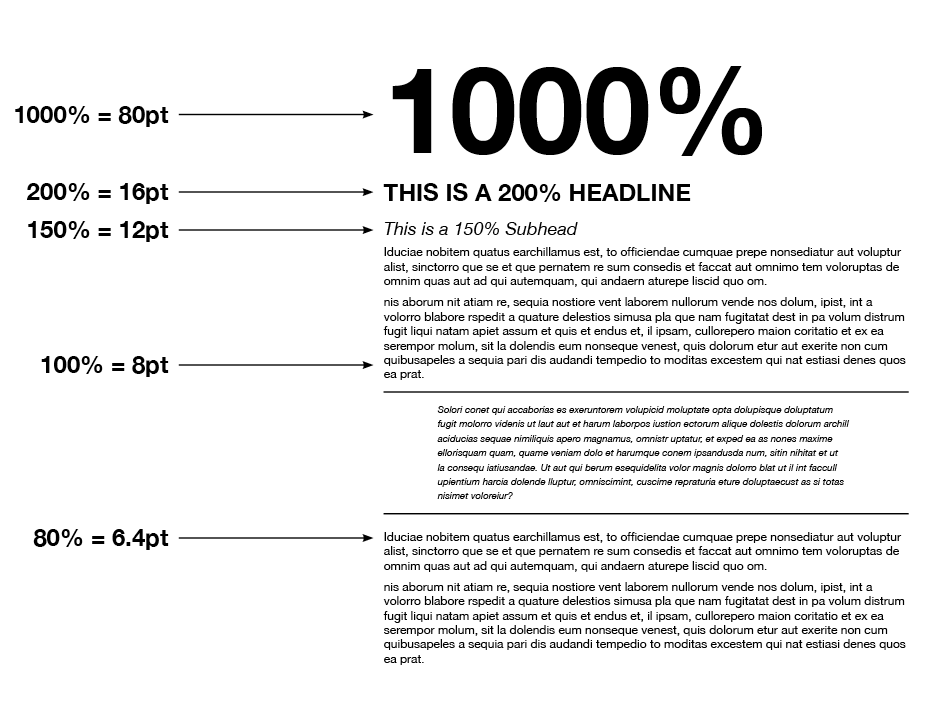Creating Percentage-based Styles
Normally when you’re setting your paragraph styles you must specify a font size. If you want to shrink your entire layout by 20%, you have to go to each style and manually alter it. I don’t know about you, but that seems like way more work that it needs to be.
Setting your percentage based styles
1. Create a base style (ex- 10pt Helvetica – named 100%).
2. Create a new paragraph style based on the 100% style, but under “Advanced Character Formats” change both the horizontal and vertical scale. This makes the style a specific percentage larger or smaller than the base.
3. Create styles that are 150%, 200%, 1000% and 80% of the base size.
4. Now that all of my styles are complete you can easily scale the entire layout by changing the base paragraph style by a point or two and redefining the style.
Before changing the base style (100% = 10pt)
After changing the base style (now 100% = 8pt)
There are a few issues that will crop up with this process.
1. Leading can not be scaled. This is probably the biggest issue with this technique, but if your headlines are all 1 line, it will not be a problem.
2. If you have large headline at the top of a text frame, it will extend out.
This can be resolved by going to text frame options > baseline options and increasing the minimum 1st baseline accent.
While this technique may be beneficial to some, I hope that Adobe will allow percentage based styles in more areas such as leading, space before/after, paragraph rules and more. I have my fingers crossed for CS17.











This is a great idea. I do it all the time with character styles, doing it with paragraph styles can be a little confusing (especially if you have character styles that also use scaling!).
Actually, leading can be scaled if you use Autolead. You set its percentage in the Justification panel of the paragraph styles dialog.
One question – in the case of character styles used in nested styles, which scaling option takes precedence? The one defined in the character style or the one in the paragraph style?
With regard to autoleading – doesn’t that take its starting measure as the size of the text regardless of what horizontal/vertical scaling is applied?
So 10pt text on 120% autoleading will be given 12pt leading (10/12), but if 80% horizontal/vertical scaling is used the leading remains at 12pt, though you might have expected the result to be 8/9.6
Tim,
You are correct, it does (or “it doesn’t”) — anyway, Auto-leading uses the original font size and does not take scaling into account.
Quentin:
Character styles take precedence and replace what’s in the paragraph style, as always. One would think (I just did) it would take a percentage of the percentage, but that doesn’t work for anything else. Color, to name something else, is not mixed but replaced; Bold text plus an italic character style does not yield Bold Italic text.
This reminds me of how you spec type for web sites via CSS, as percentages of an em. Interesting!
Speaking of percentage-based styles, I do hope they’ll integrate this into object styles as well – I’d dearly love to be able to define things like stroke width or drop-shadow offset as a percentage instead of having to tweak them manually each time I scale an object.
Let’s pray CS43 does it. :-p
@Anne-Marie – The em percentages in web design was part of my inspiration for this post.
Good idea – as long as you accept that all enlargements (reducements) are calculated electronically (and not by different dedicated fonts in the appropriate font sizes).
However, this is the way layout software today goes.
Another thing that I really miss is the ability to reduce the point size of a particular font by an absolute value! Consider a character style “minus 1.5 pt” – regardless of what the actual point size is.
Rudi
this really sounds like an approach Adobe should look into integrating into the software. there would seem to be a lot of possibilities with this, if implemented properly (i.e., not a workaround but something designed to work throughout a number of functions).
…and why we don’t hav %%% now
Seriously, this. If Adobe wants anyone to use InDesign for digital projects, we need to be able to use digital units like ems, rems, percentages, and even vm and vh based on the page size would be great.